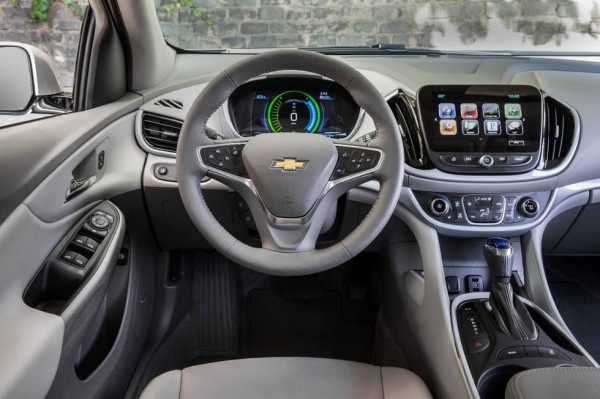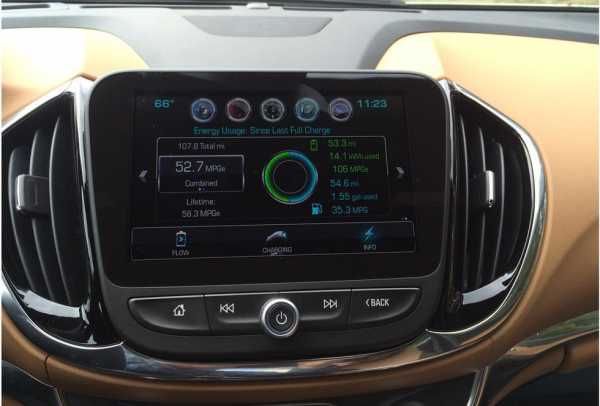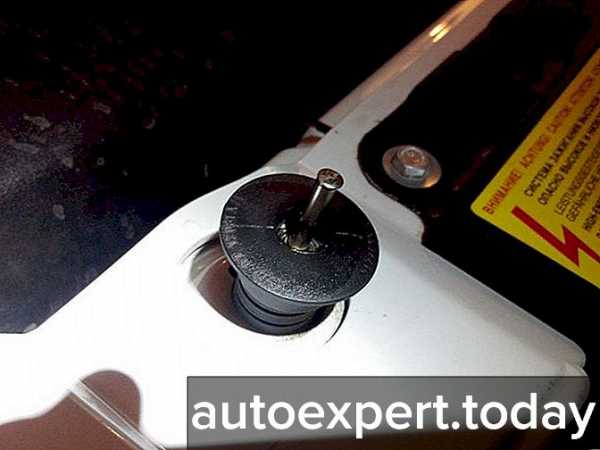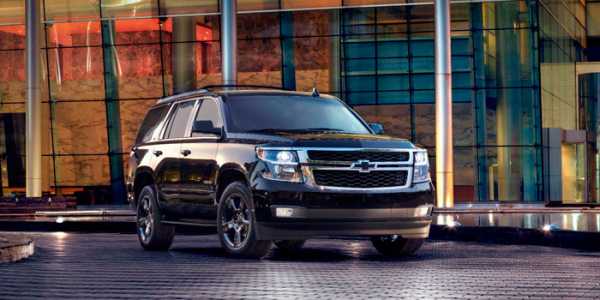Chevrolet volt 2017
2018 Volt: Plug In Hybrid
*The Manufacturer's Suggested Retail Price excludes destination freight charge, tax, title, license, dealer fees and optional equipment. Click here to see all Chevrolet vehicles' destination freight charges.
-
EPA-estimated 53-mile range based on 106 MPGe combined city/highway (electric); 367-mile extended range based on 42 MPG combined city/highway (gas). Your actual range may vary based on several factors, including temperature, terrain, and driving technique.
-
Each individual’s tax situation is unique. Consult your tax professional prior to claiming any tax-related credits to confirm the vehicle tax benefits for which you may be eligible. Must be claimed by the owner after the purchase or lease of a new Chevrolet Volt.
-
Charge times may vary with temperature and amperage settings.
-
For 2016 and 2017 model year owners.
-
Based on initial vehicle movement.
-
EPA-estimated 53-mile range based on 106 MPGe combined city/highway (electric); 367-mile extended range based on 42 MPG combined city/highway (gas). Actual range varies based on several factors, including temperature, terrain, and driving technique.
-
Based on data provided by the Bureau of Transportation Statistics (last updated May 2017).
-
EPA-estimated 53-mile range based on 106 MPGe combined city/highway (electric); 367-mile extended range based on 42 MPG combined city/highway (gas). Your actual range may vary based on several factors, including temperature, terrain, and driving technique.
-
For 2016 and 2017 model year owners.
-
Whichever comes first. See dealer for limited warranty details.
-
EPA-estimated 53-mile range based on 106 MPGe combined city/highway (electric); 367-mile extended range based on 42 MPG combined city/highway (gas). Actual range varies based on several factors, including temperature, terrain, and driving technique.
-
Feature unavailable in cold weather and at or near full charge.
-
Charge times may vary with temperature and amperage settings.
-
Using the 120-volt portable charge cord will take approximately 19 hours at the default 8-amp setting and can be reduced to 13 hours at the 12-amp setting. Actual time may vary with temperature.
-
Requires compatible Apple or Android device and data connection. Remote Services require paid plan.
-
Service varies with conditions and location. Requires active service plan and paid AT&T Data plan. See onstar.com for details and limitations.
-
Always use seat belts and child restraints. Children are safer when properly secured in a rear seat in the appropriate child restraint. See the Owner’s Manual for more information.
-
OnStar Advisors are certified by the International Academies of Emergency Dispatch.
-
Whichever comes first. See dealer for details.
-
Roadside service provided by Allstate Roadside Services. Limitations apply.
-
With 5.3L EcoTec3 V8 engine. Based on GM Large SUV segment and EPA-estimated MPG highway: 23 (2WD), 22 (4WD).
-
MyLink functionality varies by model. Full functionality requires compatible Bluetooth and smartphone, and USB connectivity for some devices.
-
Dependability based on longevity: 1987 – July 2017 full-size pickup registrations.
-
Dependability based on longevity: 1987–July 2017 full-size pickup registrations.
-
With rear seats folded. Cargo and load capacity limited by weight and distribution
-
EPA-estimated 29 MPG city/39 highway with 5-speed manual transmission and 30 MPG city/38 highway with available Continuously Variable Transmission
-
EPA-estimated 29 MPG city/38 highway with 5-speed manual transmission and 30 MPG city/38 highway with available Continuously Variable Transmission.
-
EPA estimated with 3.6L V6 engine.
-
Cargo and load capacity limited by weight and distribution.
-
EPA estimated with 3.6L V6 engine
-
Chevrolet Infotainment System functionality varies by model. Full functionality requires compatible Bluetooth and smartphone, and USB connectivity for some devices.
-
EPA estimate for Sonic with available 6-speed automatic transmission.
-
With rear seats folded. Cargo and load capacity limited by weight and distribution.
-
Always use seat belts and child restraints. Children are safer when properly secured in a rear seat in the appropriate child restraint. See your vehicle Owner’s Manual for more information.
-
With rear seats folded. Cargo and load capacity limited by weight and distribution.
-
EPA-estimated 238-mile EV range. Your actual range may vary based on several factors including temperature, terrain, and driving technique.
With second row seats folded flat. Cargo and load capacity limited by weight and distribution.
EPA-estimated 238-mile EV range. Your actual range may vary based on several factors including temperature, terrain, and conditions.
Read your vehicle owner's manual for important feature limitations and information.
Read your vehicle owner's manual for important feature limitations and information.
EPA-estimated MPG highway for Cruze Sedan with 1.4L 4-cylinder engine and transmission.
With rear seats folded. Cargo and load capacity limited by weight and distribution.
Read the vehicle owner's manual for important feature limitations and information.
EPA-estimated MPG highway for Cruze Sedan with 1.4L 4-cylinder engine.
EPA-estimated 37 MPG highway for Cruze Premier Hatchback.
Cargo space for Cruze Hatch with rear seats folded. Cargo and load capacity limited by weight and distribution.
Read the vehicle owner's manual for important feature limitations and information.
EPA-estimated 1.5L engine 29 MPG city/36 highway.
Cargo and load capacity limited by weight and distribution.
Visit my.chevrolet.com/learn for vehicle and smartphone compatibility.
Read the vehicle Owner's Manual for important feature limitations and information.
Requires available Performance Exhaust or Z51 Performance Package.
Requires available Performance Exhaust or Z51 Performance Package.
EPA-estimated 28 City/39 Hwy MPG
With second row seats folded flat. Cargo and load capacity limited by weight and distribution.
Read the vehicles Owner’s Manual for more important feature limitations and information.
Does not detect people or items. Always check rear seat before exiting.
Premier shown seats seven. Standard on L, LS. Available on LT.
EPA-estimated 18 MPG city/ 27 MPG highway 3.6FWD.
With second and third row seats folded flat. Cargo and load capacity limited by weight and distribution.
EPA-estimated 18 MPG city/ 27 MPG highway 3.6FWD.
Read the vehicle owner's manual for important feature limitations and information.
EPA-estimated 25 MPG city/31 highway (FWD models).
With rear seats folded. Cargo and load capacity limited by weight and distribution.
With 5.3L EcoTec 3 engine. EPA-estimated MPG city/highway: Suburban 2WD 15/22, 4WD14/21.
Based on GM Large SUV segment. With 5.3L EcoTec 3 engine. EPA-estimated MPG city/highway: Tahoe 2WD 15/22, 4WD 15/21.
With second and third row seats folded flat. Cargo and load capacity limited by weight and distribution.
With available Duramax 6.6L Turbo-Diesel V8.
Read the vehicles Owner's Manual for more important feature limitations and information.
EPA-estimated 15 MPG city/ 20 MPG highway.
Requires short box. Cargo and load capacity limited by weight and distribution.
308 horsepower with available 3.6L V6 engine.
308 horsepower with standard 3.6L V6 engine.
Dependability based on longevity: 1987 – July 2017 full-size pickup registrations.
EPA-estimated 15 city/20 highway for 4x4 with 4.3L V6.
Requires Long Box. Cargo and load capacity limited by weight and distribution.
910 lb.-ft. @ 1600 rpm with available Duramax 6.6L Turbo-Diesel V8.
With available Duramax 6.6L Turbo-Diesel V8.
Gross Combination Weight Rating. With available Vortec 6.0L V8 engine
Express Cargo Van with extended wheelbase. Cargo and load capacity limited by weight and distribution.
Requires Vortec 6.0L V8 engine
With available Vortec 6.0L V8 engine.
With available Vortec 6.0L V8 engine.
Equipment from independent suppliers is not covered by the GM New Vehicle Limited Warranty. GM is not responsible for the safety or quality of independent supplier alterations.
Requires available 6.0L V8 engine.
2017 Chevy Volt Premier
Originally introduced in late 2010, the Chevrolet Volt is now a veteran plug-in hybrid electric vehicle (PHEV) that has a lot more competition than when it debuted almost seven years ago. A complete redesign of the 2016 model gave it more than 50 miles of all-electric range—a 25-percent increase over the previous version, and far more than most rival cars. Key driver assists—including adaptive cruise control and upgraded automatic emergency braking—have been added to the 2017 Volt, making it a vehicle that's not only more efficient and easier to drive, but also safer. They also help make it our Editors' Choice for PHEVs.
Pricing and Design
The 2017 Volt comes in two trim levels. The LT starts at $34,095, and the Premier that we tested starts at $38,445. The Volt is eligible for a federal tax credit of up to $7,500, as well as various state tax incentives.
All 2017 Volts come with twin electric motors combined with a 1.5-liter gasoline engine/generator to produce a total of 149 horsepower. The car's 18.4kWh lithium-ion battery pack powers the two electric motors and is recharged by connecting a supplied 120-volt portable cord or a professionally installed 240-volt charging system into a lighted plug in the driver's side front fender. The battery fully recharges in approximately 13 hours at 120 volts, or in about 4.5 hours at 240 volts. The battery also charges on the fly by the gas engine/generator through regenerative braking.
The gasoline engine kicks in to help the electric motors when the car requires quick acceleration for passing or climbing steep inclines. The 2017 Volt has a single-speed direct-drive transmission powering the front wheels.

View All 8 Photos in Gallery
Standard features on the LT trim include 17-inch painted aluminum wheels, low-rolling-resistance tires, automatic LED low-beam headlights, halogen high-beam headlights, LED daytime running lamps and taillights, and power and body-colored exterior mirrors. It also has an electronic parking brake, cruise control, keyless entry and ignition, remote start, 60/40-split folding rear seats, automatic climate control, power windows and doors, a rearview camera, a cargo cover, and a leather-wrapped tilt and telescoping steering wheel with audio controls.
Standard tech features include a reconfigurable LED instrument panel, Chevy's MyLink 8-inch touch-screen interface, Apple CarPlay, Bluetooth for phone calls and wireless streaming, OnStar with 4G LTE in-cabin Wi-Fi, a Teen Driver mode, and a six-speaker sound system with AM/FM/satellite radio, dual USB ports, and an aux-in jack.
The Premier trim we tested adds machined-finish 17-inch aluminum wheels, heated exterior mirrors, an auto-dimming rearview mirror, leather seating surfaces, heated front seats, wireless charging for smartphones, automated parallel and perpendicular parking, and an eight-speaker Bose premium audio system.
Our test car also had the $495 Driver Confidence option package that includes driver assists such as blind spot monitoring, lane departure warning, and rear cross traffic alert, as well as the Driver Confidence 2 package, also $495, that adds forward collision warning with automatic low-speed emergency braking, lane departure intervention, and adaptive headlights. Individual options on our test car included $495 to add navigation to the MyLink system, and $20 for a front license plate bracket. With a destination charge of $875, this brought the total sticker to $39,950.
The Volt's exterior, updated in the 2016 model's complete redesign, eschews the self-conscious concept car appearance of the original in favor of looking like a modern compact sedan. The interior is more upscale than the previous model, with higher-quality materials and two-tone color schemes. And while a third rear seat was added in the 2016 model, bringing passenger capacity to five, a center console extension makes it almost impossible for anyone other than a small child to comfortably sit in it.
Interface and Connectivity
Fortunately, the redesign of the 2016 model did away with the difficult capacitive touch controls used in the first-generation Volt for infotainment and climate functions, and replaced them with knobs and switches. Supplementing these physical controls is the 8-inch Chevy MyLink touch-screen interface, which is easy to use and features sharp graphics and a logical menu structure.

In addition to infotainment functions, MyLink is also the main interface for energy usage info and charging settings, such as GPS-enabled location-based charging that's part of the Volt Premier's nav system. Whether you select to charge the battery at home or at work, or at a set time each day of the week, when plugged in the vehicle remembers the location via GPS and defaults to the preferred charging setting.
MyLink features just one streaming music app, Pandora, but iHeartRadio, Rdio, Spotify, and Stitcher are available through Apple CarPlay. CarPlay also supports non-music apps like Audible and MLB At Bat, and has calling and texting functions that outperform those that come with the car.
Similarly, CarPlay's Maps app has connected search capability and the Volt's built-in navigation doesn't. But the onboard nav provides a GPS-enabled, location-based charging feature and also displays maps and directions in the instrument panel and syncs with OnStar so destinations can be sent directly to the car.
Volt buyers get OnStar's basic plan for five years, which includes features such as vehicle diagnostics and dealer service alerts, as well as access to the OnStar RemoteLink app that allows locking/unlocking the car's doors, starting the engine, flashing the lights, finding the vehicle on a map, checking stats such as fuel level and tire inflation pressure, programming various battery-charging modes, and more. The 2017 Volt also comes with six months of other OnStar services such as automatic crash notification and live navigation assistance and three months or 3GB of data, whichever comes first, for in-car Wi-Fi.
Performance and Conclusions
While the Volt's primary selling points are eco-friendliness and fuel economy, you don't want to sacrifice performance. Acceleration is admirable in both electric and hybrid/gasoline mode, and the electric motor gives the car extra boost when passing and on inclines. The Volt has a quiet and smooth ride and adept handling on winding roads, although when pushed the limitations of the compliant suspension and economy-minded tires become obvious.

The Volt has four drive modes: Normal for everyday driving, Sport for quicker response, Mountain to reserve battery power on steep uphill roads, and Hold that engages the extended-range mode to save the battery power for use when it's more efficient. It also has a steering wheel-mounted paddle for extra brake regeneration, although that gives the car more of a jerky feeling.
That the Volt can go up to 53 miles on battery power means most owners can drive gas-free if they have short commutes. And unlike with pure EVs, there's no range anxiety since you can always switch to the gas engine, which achieves an impressive 42mpg on its own.
The alternative-fuel vehicle market has matured over the last five years, and PHEVs like the Kia Optima Plug-in Hybrid and the new Hyundai Ioniq have given the Volt some competition. But on a full charge, the 2017 Chevy Volt can realize almost twice as many electric-only miles as those rivals. And although the Kia offers more spacious cabins and other perks and the Ioniq is less expensive, the Chevy Volt is the first and still the best plug-in electric hybrid compact sedan. Improvements to the 2017 model make it even more attractive—and our Editor's Choice for the category.
2019 Bolt EV Electric Car: An Affordable All-Electric Car
*The Manufacturer's Suggested Retail Price excludes destination freight charge, tax, title, license, dealer fees and optional equipment. Click here to see all Chevrolet vehicles' destination freight charges.
-
EPA-estimated 238-mile EV range. Your actual range may vary based on several factors including temperature, terrain, and driving conditions.
-
EPA-estimated 238-mile EV range. Your actual range may vary based on several factors including temperature, terrain, and driving technique.
With second row seats folded flat. Cargo and load capacity limited by weight and distribution.
EPA-estimated 238-mile EV range. Your actual range may vary based on several factors including temperature, terrain, and conditions.
Read your vehicle owner's manual for important feature limitations and information.
Read your vehicle owner's manual for important feature limitations and information.
Tax, title, license, dealer fees and optional equipment extra.
EPA-estimated 238-mile EV range. Your actual range may vary based on several factors including temperature, terrain, and conditions.
EPA-estimated 238-mile EV range. Your actual range may vary based on several factors including temperature, terrain, and driving technique.
Charging rate varies based on output of the charge unit, vehicle settings and outside temperature.
Government 5-Star Safety Ratings are part of the National Highway Traffic Safety Administration’s (NHTSA’s) New Car Assessment Program (www.nhtsa.gov).
Charging rate varies based on output of the charge unit, vehicle settings and outside temperature.
Service varies with conditions and location. Requires active service plan and paid AT&T Data plan. See onstar.com for details and limitations.
Requires compatible Apple or Android device and data connection. Remote Services require paid plan.
Cargo and load capacity limited by weight and distribution.
EPA-estimated 151-miles EV range.
EPA-estimated 119 MPGe city/highway combined. Your actual range may vary based on several factors including temperature, terrain, conditions.
EPA-estimated 112 MPGe city/highway combined.
With second row seats folded flat. Cargo and load capacity limited by weight and distribution.
Whichever comes first. See dealer for details.
Roadside service provided by Allstate Roadside Services. Limitations apply.
EPA-estimated 238-mile EV range. Your actual range will vary based on several factors including temperature, terrain and driving conditions.
Cargo and load capacity limited by weight and distribution.
Chevrolet Infotainment System functionality varies by model. Full functionality requires compatible Bluetooth and smartphone, and USB connectivity for some devices.
Read the vehicle owner's manual for important feature limitations and information.
With 5.3L EcoTec3 V8 engine. Based on GM Large SUV segment and EPA-estimated MPG highway: 23 (2WD), 22 (4WD).
MyLink functionality varies by model. Full functionality requires compatible Bluetooth and smartphone, and USB connectivity for some devices.
Dependability based on longevity: 1987 – July 2017 full-size pickup registrations.
Dependability based on longevity: 1987–July 2017 full-size pickup registrations.
With rear seats folded. Cargo and load capacity limited by weight and distribution
EPA-estimated 29 MPG city/39 highway with 5-speed manual transmission and 30 MPG city/38 highway with available Continuously Variable Transmission
EPA-estimated 29 MPG city/38 highway with 5-speed manual transmission and 30 MPG city/38 highway with available Continuously Variable Transmission.
EPA estimated with 3.6L V6 engine.
EPA estimated with 3.6L V6 engine
Always use seat belts and child restraints. Children are safer when properly secured in a rear seat in the appropriate child restraint. See the Owner’s Manual for more information.
EPA estimate for Sonic with available 6-speed automatic transmission.
With rear seats folded. Cargo and load capacity limited by weight and distribution.
Always use seat belts and child restraints. Children are safer when properly secured in a rear seat in the appropriate child restraint. See your vehicle Owner’s Manual for more information.
With rear seats folded. Cargo and load capacity limited by weight and distribution.
EPA-estimated MPG highway for Cruze Sedan with 1.4L 4-cylinder engine and transmission.
With rear seats folded. Cargo and load capacity limited by weight and distribution.
Read the vehicle owner's manual for important feature limitations and information.
EPA-estimated MPG highway for Cruze Sedan with 1.4L 4-cylinder engine.
EPA-estimated 37 MPG highway for Cruze Premier Hatchback.
Cargo space for Cruze Hatch with rear seats folded. Cargo and load capacity limited by weight and distribution.
EPA-estimated 1.5L engine 29 MPG city/36 highway.
Cargo and load capacity limited by weight and distribution.
Visit my.chevrolet.com/learn for vehicle and smartphone compatibility.
Read the vehicle Owner's Manual for important feature limitations and information.
Requires available Performance Exhaust or Z51 Performance Package.
Requires available Performance Exhaust or Z51 Performance Package.
EPA-estimated 28 City/39 Hwy MPG
With second row seats folded flat. Cargo and load capacity limited by weight and distribution.
Read the vehicles Owner’s Manual for more important feature limitations and information.
Does not detect people or items. Always check rear seat before exiting.
Premier shown seats seven. Standard on L, LS. Available on LT.
EPA-estimated 18 MPG city/ 27 MPG highway 3.6FWD.
With second and third row seats folded flat. Cargo and load capacity limited by weight and distribution.
EPA-estimated 18 MPG city/ 27 MPG highway 3.6FWD.
Read the vehicle owner's manual for important feature limitations and information.
EPA-estimated 25 MPG city/31 highway (FWD models).
With rear seats folded. Cargo and load capacity limited by weight and distribution.
With 5.3L EcoTec 3 engine. EPA-estimated MPG city/highway: Suburban 2WD 15/22, 4WD14/21.
Based on GM Large SUV segment. With 5.3L EcoTec 3 engine. EPA-estimated MPG city/highway: Tahoe 2WD 15/22, 4WD 15/21.
With second and third row seats folded flat. Cargo and load capacity limited by weight and distribution.
With available Duramax 6.6L Turbo-Diesel V8.
Read the vehicles Owner's Manual for more important feature limitations and information.
EPA-estimated 15 MPG city/ 20 MPG highway.
Requires short box. Cargo and load capacity limited by weight and distribution.
308 horsepower with available 3.6L V6 engine.
308 horsepower with standard 3.6L V6 engine.
Dependability based on longevity: 1987 – July 2017 full-size pickup registrations.
EPA-estimated 15 city/20 highway for 4x4 with 4.3L V6.
Requires Long Box. Cargo and load capacity limited by weight and distribution.
910 lb.-ft. @ 1600 rpm with available Duramax 6.6L Turbo-Diesel V8.
With available Duramax 6.6L Turbo-Diesel V8.
Gross Combination Weight Rating. With available Vortec 6.0L V8 engine
Express Cargo Van with extended wheelbase. Cargo and load capacity limited by weight and distribution.
Requires Vortec 6.0L V8 engine
With available Vortec 6.0L V8 engine.
With available Vortec 6.0L V8 engine.
Equipment from independent suppliers is not covered by the GM New Vehicle Limited Warranty. GM is not responsible for the safety or quality of independent supplier alterations.
Requires available 6.0L V8 engine.
2017 Chevrolet Volt Road Test
Ever since it appeared on the electric car scene in 2011, the Chevy Volt brought a measure of practicality and peace of mind with its supplemental gas engine that would kick in to extend the Volt's limited battery-only range. Now, redesigned for 2016, the Volt returns as a more mature and capable car. It replaces the original Volt's science experiment ambience with more conventional looks and expanded capability, most notably a commuter-friendly electric range of 50 miles.
Pricing starts at $33,170 for the LT and goes up to $37,520 for the Premier version. That's about a $6,000 price drop compared to the original Volt we tested in 2011. Plus, the Volt still benefits from the $7,500 federal tax incentive available to electric car buyers. That means that the effective purchase price ends up being about $26,500, very close to a Toyota Prius.
On the topic of cost, with current gas prices -- which sit in the low $2.00 per gallon range -- there is nearly no real cost benefit to driving the Volt over a Toyota Prius, which gets 52 mpg overall. The only time the Volt makes more fiscal sense than the Prius is if you pay less than 13 cents per kWh of electricity to recharge the battery, and rarely use the Volt's gas engine.
When the Volt's battery is full, it operates just like an electric car for about 50 miles -- covering most typical commutes on a single charge. Once the battery level drops to a low level, the car makes a commendably smooth transition to gas mode (charge sustaining). In that mode, the car operates pretty much as a traditional hybrid with sufficient electric power for low-speed driving, typically up to 25 mph. In that mode alone we measured 38 mpg.
With the Volt's small 8.9-gallon fuel tank, that translates to additional 340 miles range, on top of its electric-only portion, for a total range of 390 miles. That eliminates range anxiety typical of nearly all electric vehicles. Driving purely on electric power, the Volt consumed 3.1 miles/kWh which is the equivalent of 105 MPGe. A full charge takes about 16 kWh, which on a national average electricity price of 12 cents costs less than $2.00.
Regardless of mode, the Volt benefits from a robust and smooth power delivery thanks to the electric motor's wallop of torque. We clocked acceleration at 8 seconds from 0-60 mph.
With our 240-volt connector, we observed a charging time of 4.5 hours. A portable home kit allows for charging on regular household 120-volt line, but that takes an impractical 18 hours on the default setting or 13 hours on a quicker setting. That's a long time, but it still shows that an overnight charge is feasible without having to invest in a dedicated home charger.
Ride comfort and noise isolation are commendable in the Volt. The suspension irons out just about any bumpy pavement, lending the car a solid and mature feel. Overall, the Volt feels a lot more substantial than the Prius, its natural rival in the green arena.
Handling is initially responsive in regular driving, but the Volt shows no verve in the way it tackles corners. When you really want to maximize the electric range by keeping your momentum through corners, the car becomes reluctant to change direction. Some body lean and more steering input lets you know the Volt is not sporty.
To its credit, the brake pedal feels more like a traditional car, despite the regenerative braking that typically makes an EV's brakes feel grabby. A paddle by the steering wheel lets you maximize regenerative braking, which in turn can increase range.
The Volt retains its versatile hatchback configuration which aids practicality. While the original Volt could only seat four people, the current Volt is, at least theoretically, a five-passenger car. But still, the rear seat is extremely cramped and that middle position is symbolic. It's even difficult to securely install a child seat in that position.
The tradeoff of the Volt's quiet interior is that it allows you to hear the complaints of your cramped passengers. Unfortunately, the driving position suffers from a tight footwell, and neither power seats nor lumbar support adjustment are available at all. Visibility is very compromised, and getting in and out is awkward due to the Volt's low stance and styling. Getting desirable safety gear like blind-spot monitoring, forward-collision warning, and automatic emergency braking requires the top-trim Premier version.
Thankfully, the Volt's new control layout is much more conventional, eradicating the fussy original control layout. Conventional buttons now operate most functions and a prominent touch screen features GM's intuitive and full-featured MyLink infotainment system. A mesmerizing, on-screen power flow diagram allows the driver to interact with the car and adopt economical driving habits.
One downside is the Volt's climate control function. We found the heat output to be rather tepid, but thanks to optional quick-acting front seats and steering wheel heaters we were able to keep comfortable.
With increased electric driving range, more conventional controls, reduced price, and improved refinement, we embrace the changes. If your driving pattern is mostly local and you can benefit from frequent charging, the Volt is for you, but the longer your trip is, the Volt's advantage diminishes.
"Питер - АТ"
ИНН 780703320484
ОГРНИП 313784720500453












